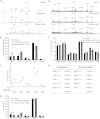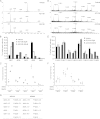Second generation γ-secretase modulators exhibit different modulation of Notch β and Aβ production
- PMID: 22851182
- PMCID: PMC3463353
- DOI: 10.1074/jbc.M112.376541
Second generation γ-secretase modulators exhibit different modulation of Notch β and Aβ production
Abstract
The γ-secretase complex is an appealing drug target when the therapeutic strategy is to alter amyloid-β peptide (Aβ) aggregation in Alzheimer disease. γ-Secretase is directly involved in Aβ formation and determines the pathogenic potential of Aβ by generating the aggregation-prone Aβ42 peptide. Because γ-secretase mediates cleavage of many substrates involved in cell signaling, such as the Notch receptor, it is crucial to sustain these pathways while altering the Aβ secretion. A way of avoiding interference with the physiological function of γ-secretase is to use γ-secretase modulators (GSMs) instead of inhibitors of the enzyme. GSMs modify the Aβ formation from producing the amyloid-prone Aβ42 variant to shorter and less amyloidogenic Aβ species. The modes of action of GSMs are not fully understood, and even though the pharmacology of GSMs has been thoroughly studied regarding Aβ generation, knowledge is lacking about their effects on other substrates, such as Notch. Here, using immunoprecipitation followed by MALDI-TOF MS analysis, we found that two novel, second generation GSMs modulate both Notch β and Aβ production. Moreover, by correlating S3-specific Val-1744 cleavage of Notch intracellular domain (Notch intracellular domain) to total Notch intracellular domain levels using immunocytochemistry, we also demonstrated that Notch intracellular domain is not modulated by the compounds. Interestingly, two well characterized, nonsteroidal anti-inflammatory drugs (nonsteroidal anti-inflammatory drug), R-flurbiprofen and sulindac sulfide, affect only Aβ and not Notch β formation, indicating that second generation GSMs and nonsteroidal anti-inflammatory drug-based GSMs have different modes of action regarding Notch processing.
Figures





Similar articles
-
First and second generation γ-secretase modulators (GSMs) modulate amyloid-β (Aβ) peptide production through different mechanisms.J Biol Chem. 2012 Apr 6;287(15):11810-9. doi: 10.1074/jbc.M111.305227. Epub 2012 Feb 13. J Biol Chem. 2012. PMID: 22334705 Free PMC article.
-
Substrate sequence influences γ-secretase modulator activity, role of the transmembrane domain of the amyloid precursor protein.J Biol Chem. 2011 Nov 18;286(46):39794-803. doi: 10.1074/jbc.M111.277228. Epub 2011 Aug 25. J Biol Chem. 2011. PMID: 21868380 Free PMC article.
-
NSAID-based γ-secretase modulators do not bind to the amyloid-β polypeptide.Biochemistry. 2011 Nov 29;50(47):10328-42. doi: 10.1021/bi201371j. Epub 2011 Nov 2. Biochemistry. 2011. PMID: 21995415 Free PMC article.
-
Development and mechanism of γ-secretase modulators for Alzheimer's disease.Biochemistry. 2013 May 14;52(19):3197-216. doi: 10.1021/bi400377p. Epub 2013 May 2. Biochemistry. 2013. PMID: 23614767 Free PMC article. Review.
-
γ-Secretase modulator in Alzheimer's disease: shifting the end.J Alzheimers Dis. 2012;31(4):685-96. doi: 10.3233/JAD-2012-120751. J Alzheimers Dis. 2012. PMID: 22710916 Review.
Cited by
-
Complex relationships between substrate sequence and sensitivity to alterations in γ-secretase processivity induced by γ-secretase modulators.Biochemistry. 2014 Apr 1;53(12):1947-57. doi: 10.1021/bi401521t. Epub 2014 Mar 20. Biochemistry. 2014. PMID: 24620716 Free PMC article.
-
Sulindac sulfide as a non-immune suppressive γ-secretase modulator to target triple-negative breast cancer.Front Immunol. 2023 Oct 13;14:1244159. doi: 10.3389/fimmu.2023.1244159. eCollection 2023. Front Immunol. 2023. PMID: 37901240 Free PMC article.
-
Biological function of Presenilin and its role in AD pathogenesis.Transl Neurodegener. 2013 Jul 17;2(1):15. doi: 10.1186/2047-9158-2-15. Transl Neurodegener. 2013. PMID: 23866842 Free PMC article.
-
γ-Secretase modulators exhibit selectivity for modulation of APP cleavage but inverse γ-secretase modulators do not.Alzheimers Res Ther. 2020 May 19;12(1):61. doi: 10.1186/s13195-020-00622-5. Alzheimers Res Ther. 2020. PMID: 32430033 Free PMC article.
-
Initial Optimization of a New Series of γ-Secretase Modulators Derived from a Triterpene Glycoside.ACS Med Chem Lett. 2012 Aug 29;3(11):908-13. doi: 10.1021/ml300256p. eCollection 2012 Nov 8. ACS Med Chem Lett. 2012. PMID: 24900406 Free PMC article.
References
-
- Portelius E., Tran A. J., Andreasson U., Persson R., Brinkmalm G., Zetterberg H., Blennow K., Westman-Brinkmalm A. (2007) Characterization of amyloid β peptides in cerebrospinal fluid by an automated immunoprecipitation procedure followed by mass spectrometry. J. Proteome Res. 6, 4433–4439 - PubMed
-
- Czirr E., Cottrell B. A., Leuchtenberger S., Kukar T., Ladd T. B., Esselmann H., Paul S., Schubenel R., Torpey J. W., Pietrzik C. U., Golde T. E., Wiltfang J., Baumann K., Koo E. H., Weggen S. (2008) Independent generation of Aβ42 and Aβ38 peptide species by γ-secretase. J. Biol. Chem. 283, 17049–17054 - PubMed
-
- Kakuda N., Funamoto S., Yagishita S., Takami M., Osawa S., Dohmae N., Ihara Y. (2006) Equimolar production of amyloid β-protein and amyloid precursor protein intracellular domain from β-carboxyl-terminal fragment by γ-secretase. J. Biol. Chem. 281, 14776–14786 - PubMed
MeSH terms
Substances
LinkOut - more resources
Full Text Sources

